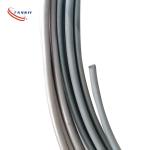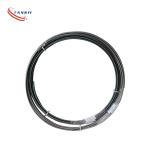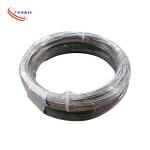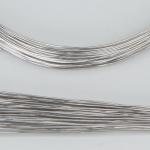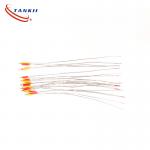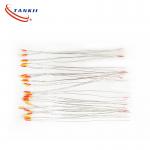NiCr NiSi (Type K) thermocouple bare wire finds the widest use in
all base metal thermocouple, at temperature above 500°C.The main
chemical composition of positive leg NiCr (KP) are Ni≈90% and
Cr≈10%; negative leg NiSi (KN) are Ni≈97% and Cr≈3%. The operating
temperature range is -200~1300°C(for short term) and 0~1100°C( for
long term).
Type K thermocouple bare wire has strong resistance to oxidation
than other base metal thermocouple bare wire. It has high EMF
against Platinum 67, excellent temperature accuracy, sensitivity
and stability, with a low cost. It is recommended for oxidizing or
inert atmospheres, but cannot be used directly in the following
cases:
(1) Alternatively oxidizing and reducing atmosphere,
(2) Atmosphere with sulphur gases
(3) Long time in vacuum
(4) Low oxidizing atmosphere such as hydrogen and carbon monoxide
atmosphere
Fe-CuNi(Constantan) (Type J) thermocouple bare wire
Fe-CuNi (type J) thermocouple bare wire is also named Fe-
Constantan thermocouple bare wire. The positive leg Fe(JP) is made
by pure Iron, and the main chemical composition of negative leg
Constantan (JN) is Cu: Ni≈ 55%: 45%. Although they are all called
Constantan, JN does not give the same EMF output curve as EN and
TN, it cannot be instead by other Constantan.
The operating temperature range of type J thermocouple bare wire is
-210~1200°C, but it is usually used in the temperature range
0~750°C due to embrittlement of Iron.
Type J thermocouple bare wire has good resistance to oxidation and
high EMF output against Platinum 67, with good temperature
accuracy, sensitivity and stability. It is recommended for vacuum,
oxidizing, reducing or inert atmospheres, but it can not be used in
sulphurous atmosphere above 500°C.
NiCr-CuNi(Constantan) (Type E) thermocouple bare wire
NiCr- CuNi (type E) thermocouple bare wire is also named NiCr-
Constantan thermocouple bare wire. The main chemical composition of
positive leg NiCr (EP) is Ni: Cr≈90:10; negative leg Constantan
(EN) is Cu: Ni≈ 55%: 45%. Although EN, TN, JN are all called
Constantan, EN and TN don not give the same EMF output curve as JN.
EN and TN are able to interchange but they are not interchangeable
with JN. The operating temperature range of type E thermocouple is
-200~900°C.
Type E thermocouple bare wire has the largest EMF output and
highest sensitivity, so it is ideal for measuring small temperature
change. It also has good stability in the low temperature range up
to 300°C, and good property of anti-corrosion in humidity
atmosphere. It is recommended for oxidizing or inert atmospheres,
but cannot be used directly in reducing atmosphere and atmosphere
with sulphur gases.
Nicrsi-NisiMg (Type N) thermocouple bare wire
Nicrsi-NisiMg (Type N) thermocouple bare wireis the latest base
metal thermocouple, developed to improve the drawbacks that type K
thermocouple wire has. The main chemical composition of positive
leg Nicrsi (NP) is Ni: Cr: Si≈84.4: 14.2: 1.4; negative leg NisiMg
(NN) is Ni: Si: Mg≈95.5: 4.4: 0.1. Type N thermocouple also be used
in the similar atmospheres that type K works, and the operating
temperature range is -200~1300°C.
Type N thermocouple bare wire improves the EMF drift and short term
EMF change, compared to type K thermocouple bare wire, and has a
longer life than type K thermocouple bare wire. Therefore, in the
industries where temperature control and measurement are especially
critical, type Nthermocouple bare wire has more advantages than
other thermocouple wire as it has long life and stable thermal EMF.
Cu-CuNi (Constantan) (Type T) thermocouple bare wire
Cu-CuNi (type T) thermocouple bare wire is also named Cu-
Constantan thermocouple wire. The positive leg Cu(TP) is made by
pure Copper, and the main chemical composition of negative leg
Constantan (TN) is Cu: Ni≈ 55%: 45%. Although EN, TN, JN are all
called Constantan, TN and EN don not give the same EMF output curve
as JN. EN and TN are able to interchange but they are not
interchangeable with JN. The operating temperature range of type T
thermocouple wire is -200~350°C, Due to the low resistance of
oxidation that Copper has, it is not advisable to go beyond that
range.
Type T thermocouple bare wire has good resistance to oxidation,
high EMF output, with good temperature accuracy, sensitivity and
stability. In the temperature range -200~0°C, it has better
property, the year stability is less than ±3μV
Fundamental Parameter:
| Grade | IEC | ASTM | DIN | GOST |
| K | Cromel-Alumel | Cromel-Alumel | Cromel-Alumel | Cromel-Alumel |
| N | Nicrosil-Nisil | Nicrosil-Nisil | Nicrosil-Nisil | Nicrosil-Nisil |
| E | Cromel-Constantan | Cromel-Constantan | Cromel-Constantan | Cromel-Constantan |
| J | Iron-Constantan | Iron-Constantan | Iron-Constantan | Iron-Constantan |
| T | Copper-Constantan | Copper-Constantan | Copper-Constantan | Copper-Constantan |
| B | PtRh30-PtRh6 | PtRh30-PtRh6 | PtRh30-PtRh6 | PtRh30-PtRh6 |
| R | PtRh13-Pt | PtRh13-Pt | PtRh13-Pt | PtRh13-Pt |
| S | PtRh10-Pt | PtRh10-Pt | PtRh10-Pt | PtRh10-Pt |
| RC/SC | Cu-CuNi (Copper-Coppernickel) | Cu-CuNi (Copper-Coppernickel) | Cu-CuNi (Copper-Coppernickel) | Cu-CuNi (Copper-Coppernickel) |
| KX | Cromel-Alumel | Cromel-Alumel | Cromel-Alumel | Cromel-Alumel |
| NX | Nicrosil-Nisil | Nicrosil-Nisil | Nicrosil-Nisil | Nicrosil-Nisil |
| EX | Cromel-Constantan | Cromel-Constantan | Cromel-Constantan | Cromel-Constantan |
| JX | Iron-Constantan | Iron-Constantan | Iron-Constantan | Iron-Constantan |
| TX | Copper-Constantan | Copper-Constantan | Copper-Constantan | Copper-Constantan
|
